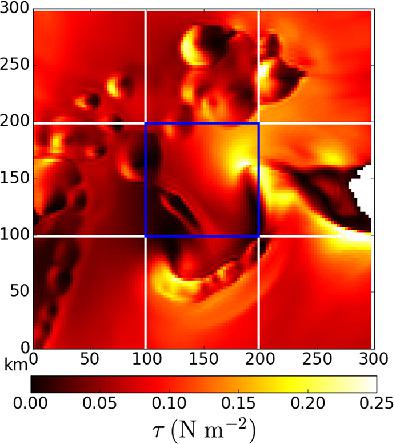当前位置:
X-MOL 学术
›
Q. J. R. Meteorol. Soc.
›
论文详情
Our official English website, www.x-mol.net, welcomes your feedback! (Note: you will need to create a separate account there.)
Meso‐scale contribution to air–sea turbulent fluxes at GCM scale
Quarterly Journal of the Royal Meteorological Society ( IF 8.9 ) Pub Date : 2020-05-13 , DOI: 10.1002/qj.3804 Sébastien Blein 1 , Romain Roehrig 1 , Aurore Voldoire 1 , Ghislain Faure 1
Quarterly Journal of the Royal Meteorological Society ( IF 8.9 ) Pub Date : 2020-05-13 , DOI: 10.1002/qj.3804 Sébastien Blein 1 , Romain Roehrig 1 , Aurore Voldoire 1 , Ghislain Faure 1
Affiliation

|
Parametrizations of sea surface turbulent fluxes used in general circulation models (GCMs) assume horizontal homogeneity of atmospheric properties at the grid‐cell scale. The present study assesses the contribution of the meso‐scale (i.e., subgrid) to the grid‐scale surface fluxes, for GCM resolution ranging from 20 to 200 km, and thus quantifies the associated GCM surface flux error. A coarse‐graining method allows for an a priori analysis of the subgrid information. It is based on an atmospheric reference dataset produced by the convection‐permitting operational model AROME. The meso‐scale relative contribution to GCM‐scale fluxes exceeding 10% is shown to have large regional patterns, with large values (up to 90%) and high frequency of occurrence (up to 76% of the time). These meso‐scale motions are not necessarily due to convective activity but also occur frequently under dynamical perturbation conditions. Contributions to surface fluxes, at both the GCM scale and the meso‐scale, are disentangled through a Reynolds decomposition. It is found that temperature and humidity meso‐scale heterogeneities do not contribute much to the GCM‐scale fluxes. The subgrid dynamical processes are the main meso‐scale contribution and consist of two parts. The first one represents the wind magnitude and wind direction heterogeneities and corresponds to the so‐called gustiness approach. It is clarified that the contribution of the gustiness wind in the transfer coefficients cannot be neglected. The second part is the contribution of the wind speed subgrid variance, which contributes up to 10% of the GCM‐scale momentum flux.
中文翻译:

GCM尺度的中尺度对海气湍流通量的贡献
在一般环流模型(GCM)中使用的海面湍流通量的参数化假设网格单元尺度上大气属性的水平均匀性。对于20至200 km范围内的GCM分辨率,本研究评估了中尺度(即子网格)对网格尺度表面通量的贡献,从而量化了相关的GCM表面通量误差。粗粒度方法允许先验分析子网格信息。它基于对流允许运行模型AROME生成的大气参考数据集。中尺度相对于GCM尺度通量的相对贡献超过10%,显示出较大的区域格局,具有较大的值(高达90%)和较高的发生频率(高达76%的时间)。这些中尺度运动不一定是由于对流活动引起的,而是在动态扰动条件下经常发生。无论是GCM尺度还是细观尺度,对表面通量的贡献都可以通过雷诺分解解开。发现温度和湿度的中尺度异质性对GCM尺度通量的贡献不大。亚网格动力学过程是主要的中尺度贡献,由两个部分组成。第一个代表风量和风向异质性,对应于所谓的“阵风”方法。需要说明的是,阵风在传递系数中的贡献不可忽略。第二部分是风速子网格方差的贡献,它贡献了GCM尺度动量通量的10%。
更新日期:2020-05-13
中文翻译:

GCM尺度的中尺度对海气湍流通量的贡献
在一般环流模型(GCM)中使用的海面湍流通量的参数化假设网格单元尺度上大气属性的水平均匀性。对于20至200 km范围内的GCM分辨率,本研究评估了中尺度(即子网格)对网格尺度表面通量的贡献,从而量化了相关的GCM表面通量误差。粗粒度方法允许先验分析子网格信息。它基于对流允许运行模型AROME生成的大气参考数据集。中尺度相对于GCM尺度通量的相对贡献超过10%,显示出较大的区域格局,具有较大的值(高达90%)和较高的发生频率(高达76%的时间)。这些中尺度运动不一定是由于对流活动引起的,而是在动态扰动条件下经常发生。无论是GCM尺度还是细观尺度,对表面通量的贡献都可以通过雷诺分解解开。发现温度和湿度的中尺度异质性对GCM尺度通量的贡献不大。亚网格动力学过程是主要的中尺度贡献,由两个部分组成。第一个代表风量和风向异质性,对应于所谓的“阵风”方法。需要说明的是,阵风在传递系数中的贡献不可忽略。第二部分是风速子网格方差的贡献,它贡献了GCM尺度动量通量的10%。


























 京公网安备 11010802027423号
京公网安备 11010802027423号